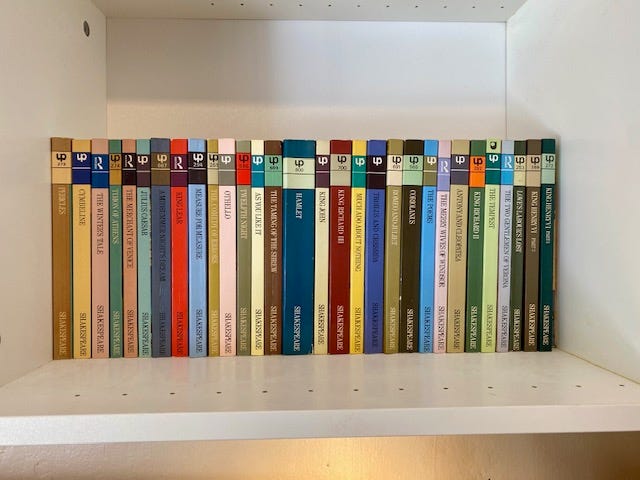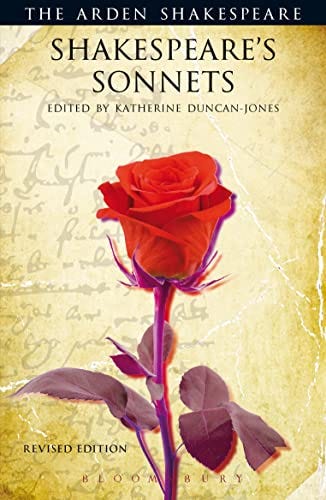
In 1964, W. H. Auden wrote: “Probably, more nonsense has been talked and written, more intellectual and emotional energy expended in vain, on the sonnets of Shakespeare than on any other literary work in the world”. While in some ways true, I must admit that one of the most fulfilling reading projects I’ve ever done is to read a sonnet a day and journal about it. I typically did this before work over a cuppa - it only took ten to 15 minutes and brought me such joy.
Prior to this, my engagement with Shakespeare’s poetry was limited to Venus and Adonis and The Rape of Lucrece, both of which I read as an English Literature undergraduate in the 1990s. Yet it bothered me that I had never read the sonnets. I bought a Penguin edition some years ago, but not only did it remain unread, I gave the book away during a brief enthusasm for Marie Kondo. When Waterstone’s opened in Lichfield, I showed my support by buying the same edition of the sonnets - but I found it hard-going without footnotes.
While some of Shakespeare’s sonnets are familiar (too familiar, perhaps) others are seriously challenging. And what are we to make of the fact that some of the sonnets are addressed to a ‘Fair Youth’ and others to a ‘Dark Lady’? What I needed was a sensible text which was both enjoyable and informative, and which didn’t go too overboard with the academic apparatus.
Enter: All the Sonnets of Shakespeare, a beautiful edition, with a luxurious cover of writhing lillies and gold-embossed lettering, which I found in the Shakespeare Birthplace Trust bookshop.1 What’s refreshing about this text is that the editors, Paul Edmondson and Stanley Wells, have set out to capture ALL the sonnets of Shakespeare, by which they mean the sonnets in the plays, such as Romeo and Juliet and Love’s Labours Lost, as well as the more familiar poems such as ‘Shall I compare thee to a summer’s day?’ (sonnet 18).2 But even more radically, they have changed the presentation of the material into what they believe is chronological order (based on modern methods of textual analysis).
Although I was new to the sonnets, I was seasoned enough to know that they were originally published (in 1609) as a series of poems to a young man – the so-called ‘procreation’ cycle – which was followed by another series addressed to a mysterious ‘Dark Lady’.3 There are several problems with this. Firstly, Shakespeare may not have authorised the edition or chosen the order in which the sonnets were published, and, secondly, the young man/dark lady dichotomy seems to have originated from the biographical approach taken by Edmond Malone in the 18th century.4 As Edmondson and Wells remark: “Malone’s influence has indeed been extensive, and over the last 250 years much ink has been spilt trying to convince us of the indentities of the real-life counterparts believed to exist in Shakespeare’s Sonnets”.5
As these editors make clear, they do not share this position, and All the Sonnets of Shakespeare goes to some lengths to break out of Malone’s biographical mindset. Instead, they present the material with a lighter touch, seeking to find “traces of [Shakespeare’s] personality” and treating them as “miniaturised dispatches from life” rather than biographical artefacts. Personally, I have always found the procreation cycle something of a slog (I know what Hesketh Pearson meant when he called the sonnets: “those sometimes beautiful but mostly tedious poems”) but by changing the order, All the Sonnets of Shakespeare breathes new life into them.
This, in itself, is quite an achivement, but the introduction and notes are excellent, and I frequently use the index of first lines. I also learnt some intriguing facts: namely, that two of the sonnets were written from the perspective of someone on horseback, and another sonnet accompanied the gift of an almanac. The book includes a short plain-English summary of each sonnet at the bottom of the page, longer plain-English summaries at the back of the book, and the occasional reminder in the notes that the poem “Could be addressed to either a male or female”, all of which are enormously helpful. Overall, it’s a wonderful edition which looks gorgeous on the shelf and provides a surprisingly fresh angle on familiar material.
If you are very new to the sonnets, however, you might want to start with something more traditional. The Arden 3rd edition of Shakespeare’s Sonnets, edited by the late Katherine Duncan-Jones, is a classic text which provides a brilliant reading experience.6 What I particularly love about it is the fact that the sonnets are numbered (in the original order) and the numbers correspond with the page numbers, which make finding your favourites quick and easy.
Duncan-Jones also wrote a forthright introduction in which she makes it clear that unusual approaches, such as that taken by Edmondson and Wells, were not to her taste (“The popular practice of rearranging the sonnets set out [in the 1609 Quarto] to produce a different overall meaning or drift is wholly unwarranted”).7 The notes are more extensive than those in All the Sonnets of Shakespeare, but they are confined to the facing pages, which means you can cover them up if you want to (I usually do this on a first reading and only check once I have made up my own mind). In addition, you get the text for A Lover’s Complaint: a narrative poem which Duncan-Jones believed to have been both by Shakespeare and thematically connected with the sonnets.8
I bought my copy of Shakespeare’s Sonnets second-hand and it was already quite battered, but this meant I was not shy about annotating my favourite poems (something I would not do with my pristine copy of All the Sonnets of Shakespeare). The notes are excellent, as is the introduction, which ranges over a wide range of key topics. Amongst them is the mystery surrounding the dedicatee of the sonnets - Mr W. H. - which Duncan-Jones claims was William Herbert, Third Earl of Pembroke. She also considers the homoeroticism of the sonnets and how this affected their critical reception. Her analysis begins with the anonymous annotator who wrote on his 17th-century copy: “What a heap of wretched Infidel Stuff”.
There are a few down-sides, such as the lacklustre cover and Duncan-Jones’s tiresome feminist readings (see her assertion that the 28 sonnets in the ‘Dark Lady’ sequence refer to the length of a menstrual cycle: a flimsy observation which she manages to mention three times!) However, her evidence around William Herbert is convincing and it would be difficult to find a more capable overview, espeically of the difficulty of dating individual sonnets. On this point, a comparison between the two editions is interesting - for example, while Duncan-Jones sees sonnets 153 and 154 as the culmination of a series in which the poet-lover may have contracted venereal disease, Edmondson and Wells - setting them at the start of their edition - claim they were schoolboy exercises in translating Greek!9
What’s clear is that Shakespeare’s sonnets remain open to interpretation, not to mention further scholarship. But their slipperiness is part of the fun - whether you take a biographical approach or simply engage in a close reading, the language has an odd way of echoing in your head as you go about your day. As Duncan-Jones observed, unlike Shakespeare’s plays, the sonnets encourage “each and every reader to arrive at an individual and original response”.10 Either of these editions would be excellent starting points on your journey.
Final tips on reading the sonnets:
Overall, it took me roughly seven-to-eight months to read all of Shakespeare’s sonnets (I took it slowly and gave myself permission to skip reading on busy days). As an exercise, I recommend selecting and curating a list of those poems which resonate the most with you. I ended up with a list of 26 which I edited down to a top 10, and then a top 3 (sonnets 12, 29 and 129 if you really want to know). You can return to these often for a re-read, but the beauty of engaging with these miniature artworks is that your favourites will change over time. Do you have any favourite sonnets or editions at the moment? Please let me know in the comments.
All the Sonnets of Shakespeare, eds. Paul Edmondson and Stanley Wells (Cambridge University Press, 2020).
Including the famous “If I profane…” scene in Romeo and Juliet – yes, it’s a sonnet, as are the plays’s opening lines.
Published as Shakespeare’s Sonnets: Never Before Imprinted.
While Edmondson and Wells express an element of doubt around the legitimacy of the 1609 Quarto, Katherine Duncan-Jones (see below) was firm in her belief that it was produced from a manuscript authorised by Shakespeare. She speculates that the odd circumstance of having the printer’s initials, instead of the author’s, beneath the dedication came about because plague forced Shakespeare to leave London in a hurry.
All the Sonnets of Shakespeare, pp. 22-3.
Shakespeare’s Sonnets, ed., Katherine Duncan-Jones (Bloomsbury, 2010).
Ibid., p. 102.
Ibid., p. 95.
For explanations see Shakespeare’s Sonnets, p. 95; All the Sonnets of Shakespeare, pp. 4-5.
Shakespeare’s Sonnets, p. 97.






